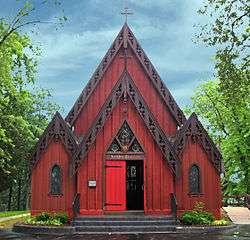St. John Chrysostom Church (Delafield, Wisconsin)
St. John Chrysostom Church, also known as the Episcopal Church of St. John Chrysostom and the Little Red Church on the Hill, is a wooden Episcopal church built in 1852 in Delafield, Waukesha County, Wisconsin. In 1972 it was listed on the National Register of Historic Places.[2]
St. John Chrysostom Church | |
 | |
  | |
| Location | 1111 Genesee St., Delafield, Wisconsin |
|---|---|
| Coordinates | 43°3′49″N 88°24′19″W |
| Area | 0.5 acres (0.20 ha) |
| Built | 1853 |
| Architect | Richard M. Upjohn |
| Architectural style | Carpenter Gothic |
| NRHP reference No. | 72000069[1] |
| Added to NRHP | February 23, 1972 |
Still, St. John is an active parish in the Episcopal Diocese of Milwaukee. Its current priest is the Rev. Philip J. Cunningham.[3]
Background
St John's was built from 1851 to 1853, a wooden structure with Gothic Revival style typified in the vertical emphasis and the pointed arches on the openings. Local tradition holds that Ralston Cox, a founder of the congregation, designed the church,[4] but Richard Perrin, an architectural historian, argues that the design is based on one from Richard Upjohn's book Upjohn's Rural Architecture: Designs, Working Drawings, and Specifications for Wooden Church, and other Rural Structures. Perrin observes that the shape and size of the main structure, the location of pulpit, organ and choir stalls inside, the triple window, and the detail of the interior woodwork are all very close to Upjohn's design. The only major difference is that Upjohn included a tower on the church, whereas St. John's has the bell house as a freestanding structure.[5] Some of the ornamental detail also was added by local craftsmen. Carpenter Alden Kelly added the bargeboards with incised designs and the rood screen inside the church.[4] Blacksmith Jacob Luther forged the wrought-iron hinges to suggest tree branches.[2]
Father James DeKoven served as the parish's first rector from 1855 until 1859. Bishop Jackson Kemper consecrated the building on May 20, 1856. On February 23, 1972, the building was added to the National Register of Historic Places.[1][6][7][8][9]
Notable previous clergy include Arthur Anton Vogel, fifth bishop of the Episcopal Diocese of West Missouri, who served as rector from 1953 to 1957.[10]
References
- "National Register Information System". National Register of Historic Places. National Park Service. July 9, 2010.
- "St. John Chrysostom Church". Wisconsin Historical Society. Retrieved 2019-10-10.
- "St. John Chrysostom Episcopal Church: About".
- Donald N. Anderson (1971-10-11). NRHP Inventory/Nomination: St. John Chrysostom Church. National Park Service. Retrieved 2019-10-09. With 14 photos.
- Perrin, Richard W.E. (1967). The Architecture of Wisconsin. Madison: State Historical Society of Wisconsin. pp. 70–71.
- St. John Chrysostom website
- St. John Chrysostom history
- St. John Chrysostom tour
- "Images of St. John Chrysostum Church by Richard Upjohn". www.bluffton.edu.
- "In Wisconsin, An Enduring Sanctuary Was A Pioneer Dream". NPR.org.
External links
| Wikimedia Commons has media related to Saint John Chrysostom Church, Delafield. |